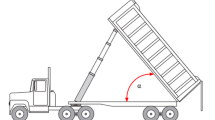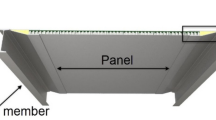Abstract
The purpose of the present paper is to lightweight design an excavator arms, by using a different materials and in particular composite material. Specifically, the research is based on the study of a commercial excavator, by determining its geometry and analyzing the load conditions to which it is exposed. These are determined in relation to either the load diagram of the machine or the possible utilities of the excavator, such as the rotation of the machine. The materials used and implemented in the different analytical and numerical elaborations are classic construction steel S 355 (UNI EN 10025–3), high-resistance steel S 890 (UNI EN 10025–6), aluminum Al 6063 T6 (UNI EN 573–3) and the composite material made by carbon fiber and epoxy resin. The adopted constraints for the design of new arms with different materials, non-conventional for these applications, are numerous. The new solutions must present a safety factor either with respect to the yield tensile strength or to the critical load of buckling greater than or equal to the one determined for the excavator in its original geometrical conformation. Another criterion, which has heavily conditioned the geometry of the arms, was given by the fact that the developed solutions must present a very similar value of the maximum displacement in the different load conditions analyzed. A new geometry for arms made by composite material was developed. It was an elliptical conic section, instead of the classic rectangular section, in order to use the filament winding technological process. As for the adoption of the composite material, we focused on the study and the design of this material as long as the interaction with the extremities (made of aluminum) which are interfaced either with the link between the arms or with the elements of the hydraulic plant which serves for the arms movement. From the results developed, it emerges that the solution developed by adopting composite materials is the one that permits the maximum weight reduction for all arms, about 68.1%, which can be seen as an increment of the maximum mass transportable about 45.5% i.e. passing from 5000 kg to 7277 kg.













Similar content being viewed by others
Explore related subjects
Discover the latest articles and news from researchers in related subjects, suggested using machine learning.References
Njuguna, J.: Lightweight Composite Structures in Transport Design, Manufacturing, Analysis and Performance, Woodhead Publishing Series in composites Science and Engineering: Number 67 (2016). ISBN: 978-1-78242-325-6 (print) ISBN: 978-1-78242-343-0 (online)
Solazzi, L.: Wheel rims for industrial vehicles: comparative and experimental analyses. Int. J. Heavy Veh. Syst. 18(2), 214–225 (2011)
Solazzi, L.: Design of an aluminium boom and arm for an excavator. J. Terrramech. 47, 201–207 (2010)
L. Solazzi, R. Scalmana: New design concept for a lifting platform made of composite material. Applied Composite Materials, An International Journal for Science and Application of Composite Materials, ISSN 0929-189X Appl. Compos. Mater. (August 2013), 20(4), 615–626, Published online: 14 September (2012). doi: 10.1007/s10443-012-9287-2
Ashby, M.F.: Materials and Sustainable Development. Butterworth-Heinemann imprint of Elvesier Ltd, Oxford (2016)
Michael, F.: Ashby: Materials Selection in Mechanical Design Third Edition (2003). Butterworth-Heinemann. ISBN:0-7506-6168-2
Agarwal, B.D., Broutman L.J., Chandrashekhara K.: Analysis and Performance of Fiber Composites, third edition, Hohn Wiley and sons, Inc. (2006)
Tiwari, A., Alenezi, M.R., Jun, S.C.: Advanced Composite Materials. ISBN: 978-1-119-24253-6 Scrivener Publishing LLC (2016)
Balasubramanian, M.: Composite Materials and Processing Press. Taylor & Francis Group, LLC (2014). ISBN: 978-14398-8054-8CRC
Kar, K.K.: Composite Materials Processing, Applications, Characterizations. Springer (2017). ISBN: 978-3-662-49512-4, ISBN: 978-3-662-49514-8 (eBook)
Various, Fatigue in composites. Woodhead Publishing Ltd, (2003)
Garmstedt, E.K., Berglund, L.A.: In: Harris, B. (ed.) Fatigue in thermoplastic composites. Woodbead Publishing Ltd, Cambridge (2003)
Åkesson, B.: Plate Buckling in Bridges and other Structures. Taylor & Francis Group (2007). ISBN: 978-0-415-43195-8
Kubiak, T.: Static and Dynamic Buckling of Thin-Walled Plate Structures. Springer (2013). ISBN: 978-3-319-00653-6, ISBN: 978-3-319-00654-3 (eBook)
Zrnic, N.D., Gašić, V.M., Bošnjak, S.M.: Dynamic responses of a gantry crane system due to a moving body considered as moving oscillator. Arch. Civ. Mech. Eng. 15 (1), 243–250. Elsevier (2015)
Bošnjak, S.M., Zrnic, N.D., Gašić, V.M., Petković, Z.D., Milovančević, M.D.: Dynamic responses of mobile elevating work platform and mega container crane structures. 562–564, 1539–1543 (2012). International Conference on Materials Engineering and Automatic Control, ICMEAC (2012); Jinan; China 27 April (2012) through 29 April (2012); Code 92998 ISBN: 978-303785458-7
Solazzi, L., Incerti, G., Petrogalli, C.: Estimation of the dynamic effect in the lifting operations of a boom crane. Proceedings of the 28th European Conference on modelling and simulation May (2014)
Talreja, R., Singh, C.V.: Damage and Failure of Composite Materials. ISBN 978-0-521-81942-8. Cambridge University Press (2012)
Author information
Authors and Affiliations
Corresponding author
Rights and permissions
About this article
Cite this article
Solazzi, L., Assi, A. & Ceresoli, F. New Design Concept for an Excavator Arms by Using Composite Material. Appl Compos Mater 25, 601–617 (2018). https://doi.org/10.1007/s10443-017-9638-0
Received:
Accepted:
Published:
Issue Date:
DOI: https://doi.org/10.1007/s10443-017-9638-0
Keywords
Profiles
- L. Solazzi View author profile




